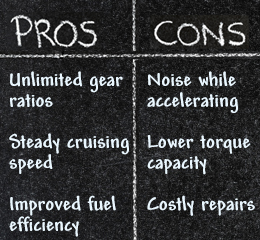
A car transmission is basically an assembly of gears and shafts that is instrumental in transmitting power from the car’s engine to the drive axle. The car transmission system facilitates the conversion of the speed of the engine and the torque into an output speed and torque, thereby making it possible to drive the vehicle at variable speeds. Transmissions can be manual or automatic. In case of a manual transmission, the driver has to shift from gear to gear with the help of a hand shifter and clutch pedal. On the other hand, an automatic transmission changes the gears automatically according to car’s speed.
A continuously variable transmission (CVT) is a type of transmission that can provide an unlimited range of gear ratios in automobiles. CVTs were earlier used in industrial applications, but car manufactures such as Nissan, Audi, Ford and Honda have been using CVT technology in their cars for some time. With their ability to provide unlimited gear ratios, cars with a CVT surely have some advantages over the conventional transmission. If you are planning to buy a car that is equipped with a CVT, it would be a good idea to find out more about the CVT mechanism and pros and cons of CVT.
How Does a CVT Work
A CVT uses a pulley and belt system to change the vehicle’s drive-wheel speed and torque in relation to engine speed and torque so as to provide an unlimited range of gear ratios. It is different from the automatic transmission which has a set number of gear ratios. A CVT uses components such as a high density rubber/metal belt, a driving pulley actuated by a hydraulic cylinder, a mechanical torque-sensing driving pulley, sensors and microprocessors to perform its function. The transmission has the ability to change continuously by using an infinite number of gear ratios between maximum and minimum values. To facilitate different gear ratios, the working diameters of the two main pulleys in the transmission need to be altered. While the pulley that is connected to the engine is called the input pulley, the one that is connected to the drive wheels is called the output pulley. One side of the pulley is fixed while the other side is movable. This movement is facilitated by a hydraulic cylinder which can change the space between the two sides of the pulley. When the pulley halves come closer to each other, the belt that runs between them goes higher on the pulley, thereby increasing the diameter of the pulley. This is how you get the unlimited gear ratios, unlike the traditional transmission, where the ratio is changed in stages by shifting gears.
Advantages and Disadvantages of CVTs
As mentioned earlier, CVTs provide unlimited gear ratios and improved performance. The infinite ratios help in maintaining a steady cruising speed. It also helps in reducing the fuel emissions and thus improves fuel economy. Due to its ability to change the ratios continuously, a CVT helps to keep the engine in its optimum power range, thereby increasing gas mileage and fuel efficiency. This kind of transmission also provides quicker acceleration than a conventional automatic. Well, these were the advantages, now it’s time to find out more about CVT problems. One of the major drawbacks is that it might not be able to provide a driving feel that a conventional automatic transmission provides. Cars that are equipped with CVT make an irritating noise especially when you try to accelerate. This noise can be compared to that of a slipping clutch. Some users have also complained of a lack of power. This may be attributed to the lower torque capacity. If you are driving a car equipped with a CVT, you might also take some time to adjust to the dynamics. Another problem associated with CVT is that the transmission fluid is a little expensive. Though automatic transmission has its own set of problems, most car owners are accustomed to the driving dynamics of an automatic transmission. Since adjusting to a CVT might take some time, manufacturers are trying to incorporate features to provide the driving feel that a refined torque converter automatic provides.
Though many car owners are aware of the problems associated with an automatic transmission, they are used to the driving feel and dynamics of an automatic transmission. So, if you are planning to buy a car equipped with a CVT, make sure that you go for a thorough test drive.